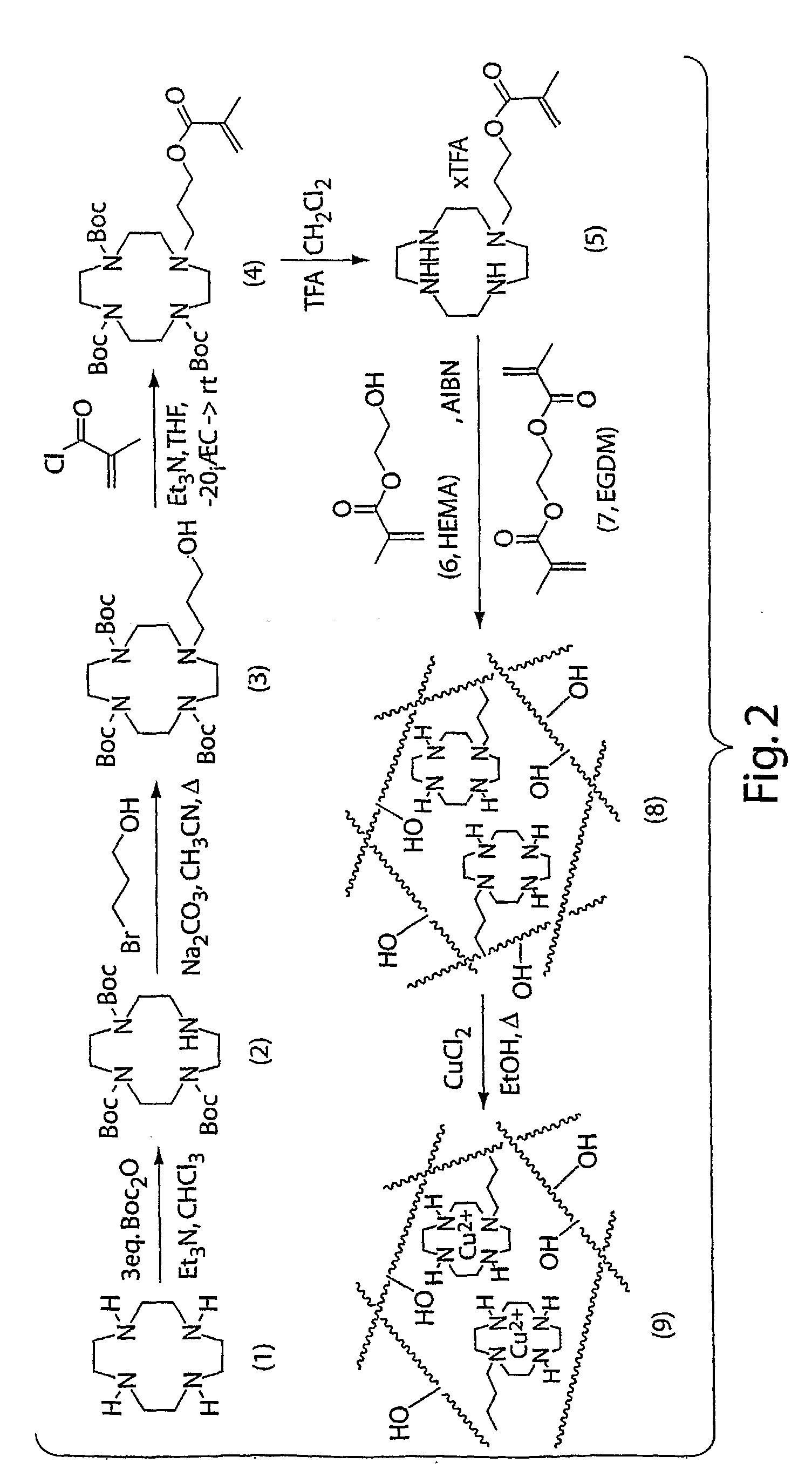Nitric Oxide Coatings for Medical Devices
a technology of nitric oxide and medical devices, applied in the direction of catheters, blood vessels, therapy, etc., can solve the problems of affecting people, occurrence of unwanted inflammatory responses, functional device failure, etc., and achieve the effect of preventing unwanted inflammatory responses
- Summary
- Abstract
- Description
- Claims
- Application Information
AI Technical Summary
Benefits of technology
Problems solved by technology
Method used
Image
Examples
example 1
Synthesis of poly(Cu(II)-cyclen-N-3-propyl methacrylate-co-2-hydroxyethyl methacrylate) Hydrogel (9)
[0113]As shown in FIG. 2, 3Boc-cyclen 2 is prepared and purified by from commercially available cyclen 1. A mixture of compound 2 and 3-bromopropanol is heated to 80° C. in the presence of sodium carbonate in acetonitrile overnight to afford 3Boc-cyclen-N-3-propanol 3 (67% over 2 steps after purification with silica gel chromatography). To introduce a polymerizable group onto compound 3, methacryloyl chloride is slowly added to a solution of compound 3 and triethylamine in dry THF at −20° C. After 1 h, the mixture is allowed to warm to room temperature. 3Boc-cyclen-N-3-propyl methacrylate monomer 4 is obtained after column chromatography with silica gel (59% yield). After deprotection of compound 4 with trifluoroacetic acid (TFA), 7.6 mol % of a crude solid compound 5 is polymerized with 2-hydroxyethyl methacrylate (6, HEMA, purified by distillation before using), and 2 wt % of ethyle...
example 2
Synthesis of poly(2-hydroxyethyl methacrylate) Hydrogel 11
[0114]Poly(2-hydroxy methacrylate) hydrogel 11, a blank hydrogel, is synthesized via 0.8 wt % AIBN, 4 wt % of EGDM, and HEMA and copper ion incorporation and purification using the same methods employed for preparation of hydrogel 9.
example 3
Nitric Oxide Generation of Blank Hydrogels, 8 and 11 from S-nitrosoglutathione (GSNO) and Glutathione (GSH)
[0115]To ensure that the NO generation is induced only from copper ions chelated by cyclen, not ions adsorbed to the polymer backbone, two blank hydrogels, 8 and 11 are investigated for their catalytic NO generation from GSNO and a reducing equivalent, GSH in the presence of a strong copper chelator, EDTA in deoxygenated PBS buffer (pH=7.4). The hydrogels, 8 and 11 are soaked separately for 1 d and bubbled with nitrogen gas for 30 min in PBS buffer (pH=7.4) prior to experiments. Hydrogel 8 does not generate NO at all, indicating that copper ions are required for NO generation. The initial immersion of hydrogel 11 into the reaction solution shows a small NO flux, but spontaneously decreases to the baseline; hence the next trial of the same polymer does not generate NO at all. The polymer matrix itself incorporates a small amount of copper ions without the cyclen moiety, causing ...
PUM
| Property | Measurement | Unit |
|---|---|---|
| Thickness | aaaaa | aaaaa |
| Thickness | aaaaa | aaaaa |
| Thickness | aaaaa | aaaaa |
Abstract
Description
Claims
Application Information
 Login to View More
Login to View More - R&D
- Intellectual Property
- Life Sciences
- Materials
- Tech Scout
- Unparalleled Data Quality
- Higher Quality Content
- 60% Fewer Hallucinations
Browse by: Latest US Patents, China's latest patents, Technical Efficacy Thesaurus, Application Domain, Technology Topic, Popular Technical Reports.
© 2025 PatSnap. All rights reserved.Legal|Privacy policy|Modern Slavery Act Transparency Statement|Sitemap|About US| Contact US: help@patsnap.com



